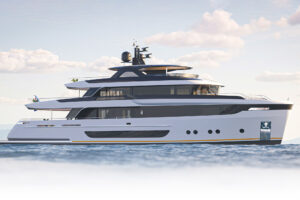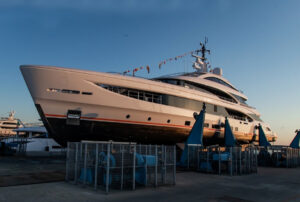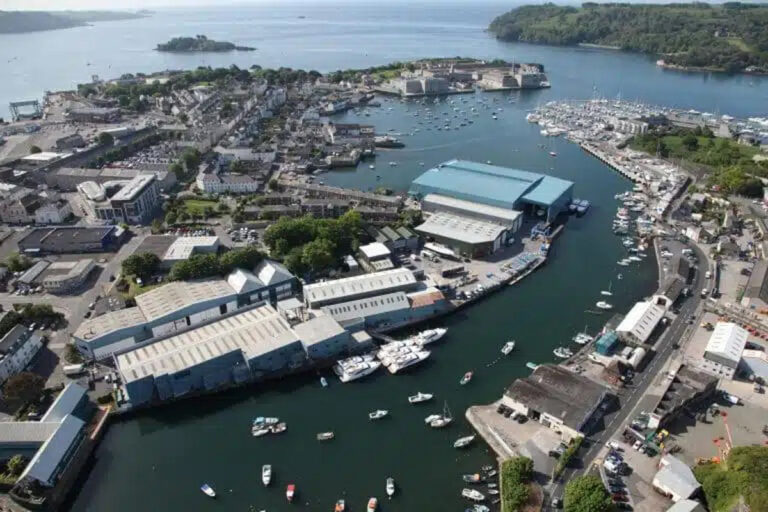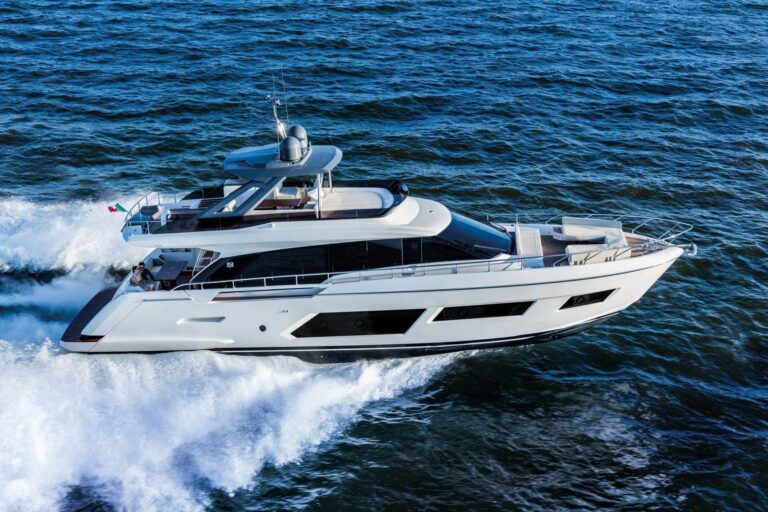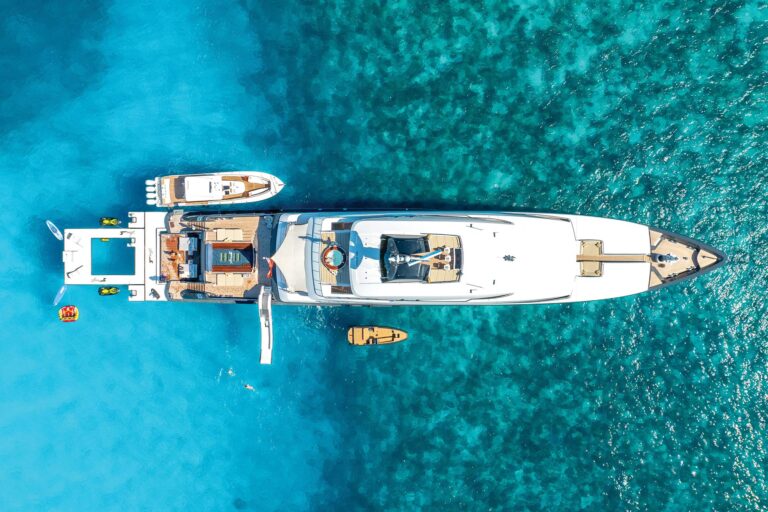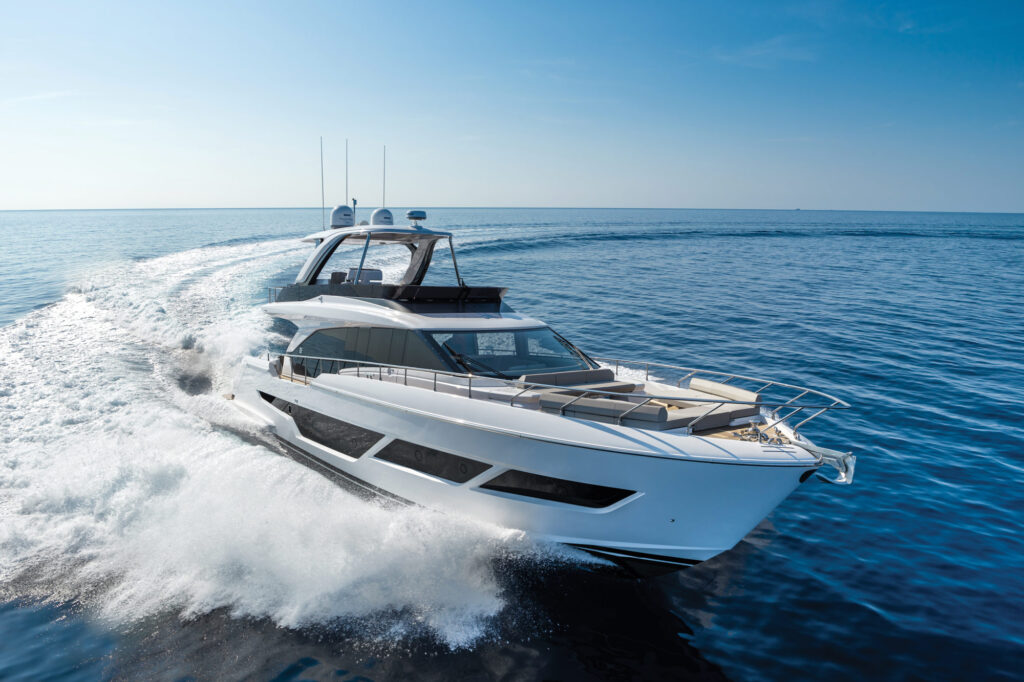
Creating a yacht from scratch is challenging, but reimagining one of your own designs might be an even tougher task. That’s exactly what designer Filippo Salvetti did when he reinvented the Ferretti Yachts 670, which, coincidentally, was his first model for the Forli, Italy-based builder in 2019.
One of the immediately noticeable and impactful changes is found in the hullside glass. Previously, there were three glass sections between the forepeak VIP stateroom and the amidships owner’s space. They were collectively shaped somewhere between a rectangle and a trapezoid. While there are still three glass sections in the current 670, the forward two have a more aggressive, lean-forward attitude and are larger, while the amidships glass is now shaped like a knife blade: thicker forward and narrowing as it travels aft. It pinches to a fine point as it resolves where the side decks meet the cockpit. Visually, this look helps to lower and elongate the 670’s profile. Practically, larger glass means more light belowdecks as well as an increased sense of volume.
When it comes to the motoryacht’s superstructure glass, it wraps nearly 360 degrees. There’s a house-spanning, single-pane windshield forward. Like the hullside glass, cut-down bulwarks amidships aid in lowering the yacht’s visual height while providing unobstructed ocean views from the salon. Add the hardtop that has forward-leaning supports—and stretches aft—and you have a vessel with proportional aesthetics from the bow to the stern and from the hardtop to the waterline.
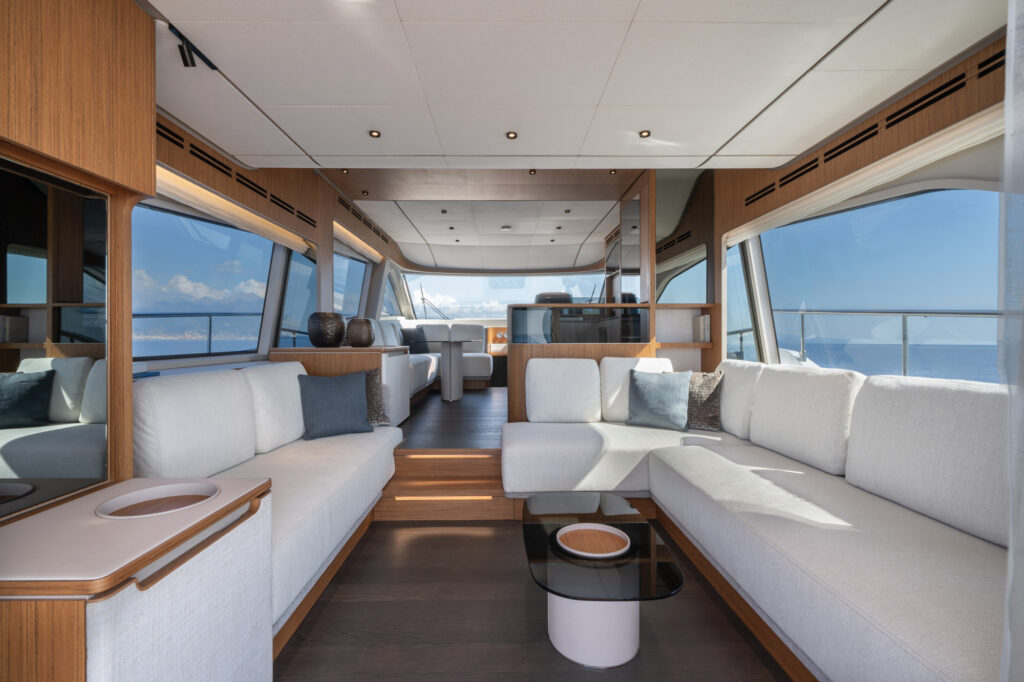
Balance of a different type is found inside the yacht, a design that comes from Ideaitalia. (The previous yacht’s interior was from Salvetti.) There are two decor schemes, dubbed classic and contemporary. The Ferretti 670 I was aboard had the classic decor with elements such as dark, varnished oak soles; natural porcelain stone galley countertops in a textured gray; Alpi teak-veneer bulkheads; creme-tone white marble; and blue accents. Overall, the color scheme adds to the ambient light, creating an airy vibe in the salon as well as in the three staterooms belowdecks.
The contemporary interior focuses on whitewashed oak soles in the salon, white Alpi bulkheads, salt-tone galley countertops, gray polished marble and more.
In addition to decor choices, the Ferretti 670 has two power options from MAN: twin 1,000 hp or 1,200 hp V-8 diesels. The yacht I was aboard had the latter option, rated at 2,300 rpm.
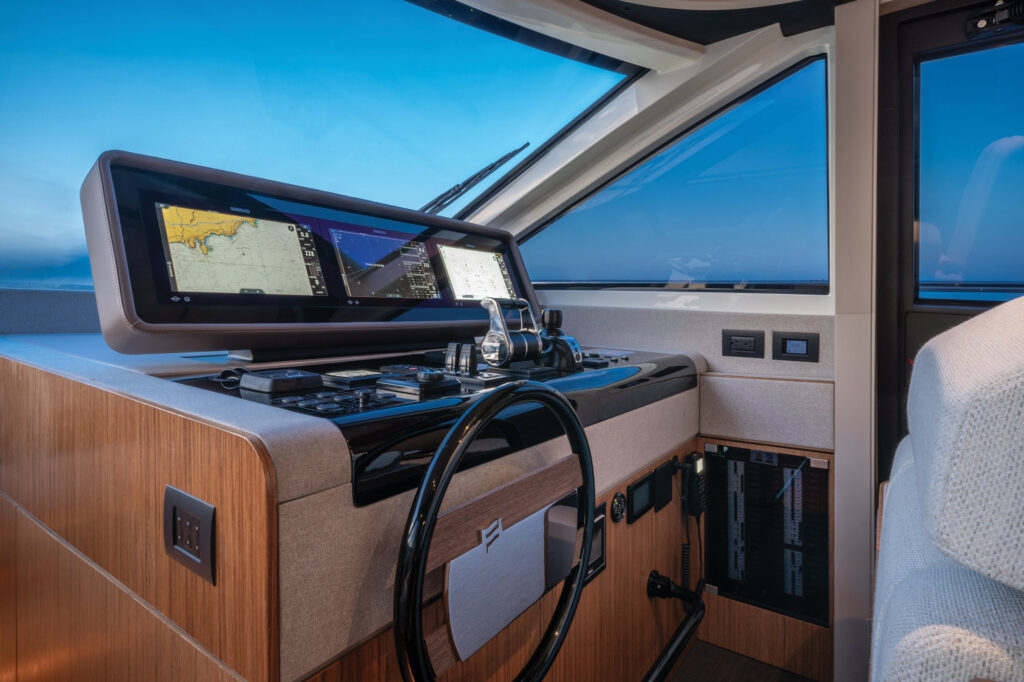
The morning was warm and humid, and the seas were calm off the coast of Cannes, France, where I saw the 670 skirt along at a 25.4-knot cruise speed at 2,000 rpm. At this speed, the engines consumed around 98.2 gallons per hour. With a 1,004-gallon fuel capacity—and considering a 10 percent reserve—that gives the yacht a range of 233 nautical miles at cruise speed. This 670 was running with eight people, about 450 gallons of fuel and 237 gallons of water. Ferretti specs the 670’s cruise speed at about 28 knots with a one-third load and six people. This yacht hit a 32-knot top hop at 2,345 rpm, which is a little above the rated rpm spec but within reasonable limits.
Both performance numbers are quite respectable for a yacht displacing 106,483 pounds (wet). Ferretti says that with the smaller MANs, cruise speed should be about 25 knots with a 28-knot top-end speed.
Other notable performance data includes the 670 getting on plane at 1,500 rpm and going from standing still to wide-open throttle in 35 seconds.
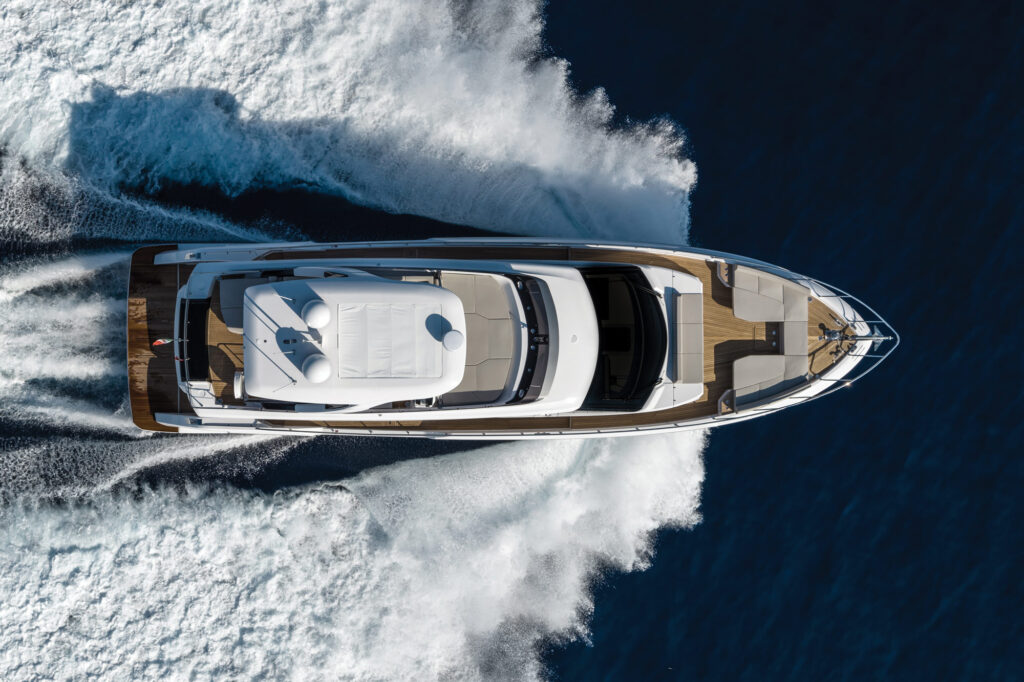
The helm experience is confidence-inspiring, with clear sightlines for nearly 360 degrees from the lower helm. Hard-over turns were completed in a couple to a few boatlengths, and were mannerly with minimal inboard heel or speed bleed. The yacht was real-time-responsive to wheel input, and the Xenta single-lever controls operated smoothly and naturally under my palm. A bolster-style helm seat allowed me to stand or lean comfortably during my wheel time.
The dash was outfitted with three Simrad multifunction displays, a Xenta joystick, and Side-Power bow and stern thrusters to assist with close-quarters handling. This 670 also had a Zipwake trim system as well as a Seakeeper NG6 gyrostabilizer, which was engaged during our time on board. There is a full upper helm too; however, this helm had two Simrad multifunction displays instead of three.
When it comes to the 670’s outdoor spaces, there are several options for entertaining and lounging. The cockpit has a folding teak dining table with a transom bench seat and loose chairs, accommodating four to six guests for lunch under the flybridge overhang as cross breezes waft over the cockpit. The flybridge is set up with U-shaped dining for eight to 10 guests to port, and with a lounge pad forward of the dual-seat helm that’s as wide as the flybridge, ensuring everyone can enjoy the views underway while keeping the skipper company. Add a couple or a few chaise lounges for even more seating aft. Last, the foredeck lounge has mirrored settees and tables to enjoy some quietude at the quay or to gather with friends for sundowners on the hook.
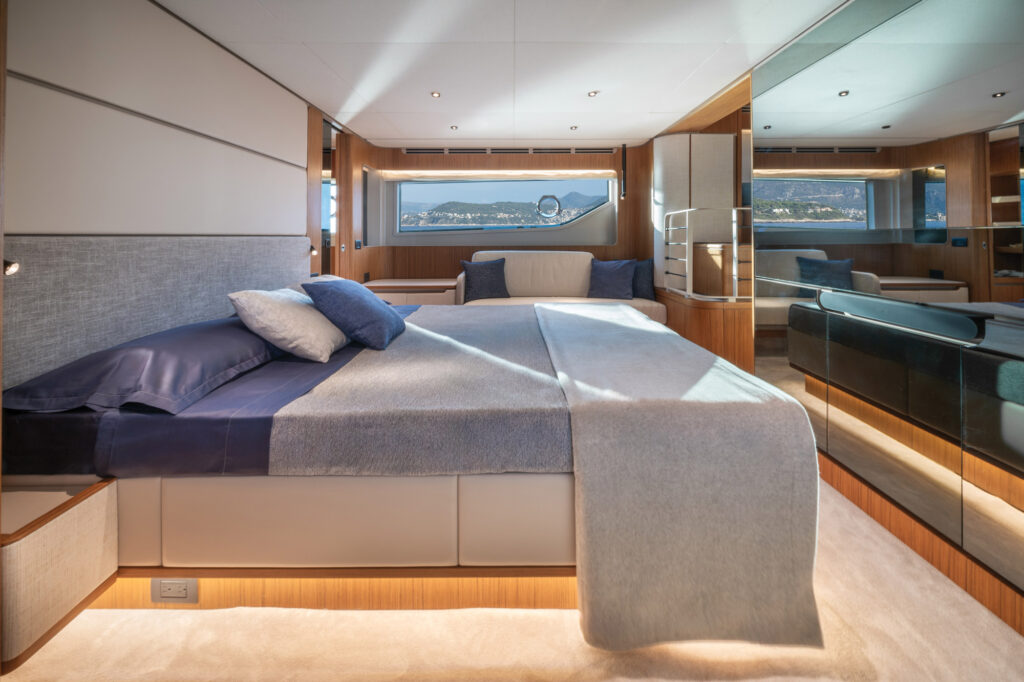
From its luxe finishes to admirable performance and ageless exterior style, this iteration of the Ferretti Yachts 670 has proved an eminently cruise-worthy craft for enthusiasts with a penchant for comfortable voyaging, and perhaps a bit more.
Get Cooking
The Ferretti 670’s galley—to starboard and abaft the helm station—is set up with a Siemens four-burner cooktop, a standing fridge and freezer, a dishwasher and a Samsung microwave. The gray, textured stone countertops are inviting, providing an artistic touch as well as a tactile experience. This galley design appeals to the palate as well as every other sense.
When Night Comes
The Ferretti 670 has a three-stateroom, three-head layout, including a full-beam amidships owner’s en suite space with an optional bidet. It’s accessed via a door to port, seven steps down from the salon. Immediately upon entering the carpeted room, there’s a leather-topped desk/vanity. Hullside glass flanking the centerline berth brightens the space, increasing perceived volume. There is a walk-in closet abaft the berth to port, while the head with a walk-in shower is abaft the berth to starboard. The settee to starboard is a good spot to take in the view with coffee before pulling the hook for the day’s adventures. The forepeak VIP has the berth set low, creating significant headroom above it. The third guest space is abaft the VIP and to starboard with side-by-side berths. A crew cabin is far aft.
Add-Ons
Some notable options for the Ferretti Yachts 670 include a 155,000 Btu tropical air-conditioning system, two Seakeeper gyrostabilizers, a flybridge hardtop, an electrohydraulic passerelle, a 21 kW Kohler generator, flybridge chaise longues, a 15.5 hp stern thruster and a cockpit steering station.
Take the next step: ferretti-yachts.com

